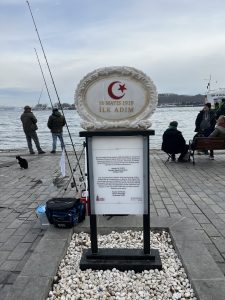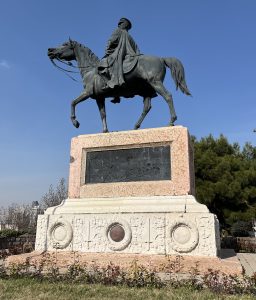No one could visit Turkey and not come across Mustafa Kemal Atatürk, the hero of the Turkish War of Independence (1919-23) and the country’s first president. So important is Atatürk to the story of the Turkish Republic that he’s remembered wherever you turn: his picture gazes down on you from every office wall, his bust or statue adorns every public square. Those who’d like to find out more about the man will be pleased to learn that there are all sorts of more interesting monuments dotting the country which commemorate the events of his life.
Atatürk’s birthplace
Mustafa Kemal was born in 1881, the son of Ali Riza Efendi and Zübeyde Hanım. His birthplace was Salonica (the modern Thessaloniki) in Greece, which was then part of the Ottoman Empire, and visitors to that town can visit the three-storey house where he grew up on production of their passport. To make things easier for those who don’t want to travel all the way to Greece, there are also two replicas of the house in Turkey. The first of them is in the Atatürk Forest Farm (Orman Çiftliği) in Ankara, the second in Kutlukent, seven kilometres east of Samsun on the Ordu road (weekdays only).
The Çanakkale battlefields
Mustafa Kemal first rose to prominence as a military leader in the Gallipoli campaign near Çanakkale during World War I. It was at Gallipoli that Atatürk helped repulse the ANZAC troops as they came ashore in what is now Anzac Cove in 1915, giving his men the famous command: “I am not ordering you to attack. I am ordering you to die.”
Later during the same campaign, he was fortunate to escape death when his pocket watch deflected a bullet at Conkbayırı (Chunuk Bair) where he had established his command post. Today, visitors to the battlefields can read his moving words to the mothers of the fallen ANZACS: “To us there is no difference between the Johnnies and the Mehmets…”
Planning the War of Independence
In the immediate aftermath of the defeat of the Ottoman Empire in World War I, Mustafa Kemal and a band of comrades started to make preparations to free Turkey from the foreign troops that were occupying it. During this period Atatürk lived briefly with his mother and sister in Şişli in İstanbul in a house on Halaskargazi Caddesi that is now a small Atatürk Museum. 
Leaving İstanbul and landing in Samsun
On 16 May 1919 Atatürk left the pier at what is now Karaköy to head for Samsun on the steamship Bandırma, an event now know as the “İlk Adım (First Step)” and commemorated there by a memorial. Three days later on May 19, 1919 he arrived in Samsun to launch the War of Independence. Today visitors to the town can walk along a boardwalk called the Kurtuluş Yolu (Liberation Way) running down to the sea that serves as a reminder of this momentous event and visit a replica of the Bandırma on which his men arrived in Samsun (it’s on the eastern outskirts of town). Then you can drop in on the Gazi Museum, housed inside the early 20th-century Mantika Palas, a grand hotel where Atatürk stayed several times. Amongst its more memorable souvenirs are his suitcase complete with barometer and a picnic basket that proves that he was not a man who believed in travelling light . Incidentally, a central district of Samsun is named İlkadım.
Amasya, Sivas and Erzurum Congresses
From Samsun Mustafa Kemal headed for the lovely inland town of Amasya to hold the first of a series of planning meetings. While there’s no museum to commemorate this in Amasya, visitors who arrive on 21 June, the anniversary of he event, will be greeted with a display of folk dancing in the main square. In Sivas the building where the rebels gathered on 4 September now houses the Atatürk Congress Museum with their photos resting on the old-fashioned wooden school desks that were used during the meeting. Finally, in Erzurum you can visit a wooden house just north of Cumhuriyet Caddesi in which Atatürk stayed on several occasions.
Ankara becomes the capital
in 1923 one of Atatürk’s first decisions as victor in the war was to move the capital of his new Turkish Republic from İstanbul to Ankara. Here you can visit the building that housed the First National Congress, which convened for the first time in April 1920 while the war was still in progress, and the rather grander building that housed the Second National Congress, a work of the architect Vedat Tek that was constructed in 1924 and served as the seat of parliament until 1960.
The Hat Law
Once installed as president, Atatürk embarked on a whirlwind programme of reforms that included the switch from writing Turkish in Arabic lettering to the use of the Latin alphabet, as commemorated by a monument on the waterfront at Kadıköy in İstanbul, and the closure of the dervish lodges (several have seen been rebuilt including the impressive Yenikapı Mevlevihanesi at Merkezefendi in İstnbul). One of the most dramatic changes came in 1925 when the wearing of fezes became illegal; the small Archaeology Museum in Kastamonu commemorates the first proclamation of the change, and displays photographs of Atatürk and friends on their new Westernised headgear. Incidentally the monument to Atatürk in Kastamonu’s main square is one of the finest in the country. (Theres’ another especially striking one in Uşak in Western Anatolia.)
Travelling Turkey
During the course of his presidency Atatürk was an inveterate traveller and few parts of the country failed to receive a visit from the great man. Many of the houses in which he stayed have been maintained as museums, generally open to the public free of charge. Although the exhibits are usually a fairly predictable collection of photographs and memorabilia labelled only in Turkish, several of the houses are worth visiting for the sake of their architecture. Finest of them all if probably the Atatürk Köşkü in Trabzon, a lovely whitewashed wooden house in a pretty garden high above the town that was built in Crimean style. However, there are also interesting Atatürk houses in Alanya, Bursa, Hacıbektaş, İzmir, Kayseri and Mersin as well as inside Ankara Gar (station). The Çelik Palas Hotel in Bursa also boasts a gorgeous marble hamam that Atatürk had installed especially so that visitors to his house nearby would be able to avail themselves of a Turkish bath.
Atatürk’s death
In October 1938, Atatürk was dining in İstanbul with friends on the presidential yacht, Savarona, when he was taken ill. He was conveyed to the nearby Dolmabahçe Palace, where he eventually died on 10 November. Since then, every clock in the palace has been stopped at 9:05, the precise moment of his death, as recorded rather movingly in pencil on the desk diary of Celal Bayar, later the country’s third president, which is on display in the Second Congress Building in Ankara. Every visit to Dolmabahçe Palace should include a visit to the room in which Atatürk died and where his unexpectedly narrow bed is draped with the Turkish flag.
Final resting place
Atatürk’s body was conveyed to Ankara , where it initially lay in state in the building that now houses the Ethnography Museum, near the Opera House that had been one of his favourite refuges. Here visitors can inspect a collection of photographs of the crowds that gathered to mourn as the coffin passed by. You can watch newsreel footage of the funeral cortege in the İş Bankası Müzesi in Ulus, Ankara. In 1941 an international competition to design a more suitable final resting place for the Father of the Turks was won by Emin Onat and Orhan Arda. Their masterpiece, the Anıtkabir in Ankara, is now one of Turkey’s most visited sites, with virtually every Turk at some point in their life walking along the path lined with imitation Hittite lions that leads to the vast memorial. The heavily guarded marble cenotaph above Atatürk’s actual tomb is very much the centrepiece although there’s also a small museum where you can find out more about the life and time of this most important of all Turks and about the Turkish War of Independence.
Written in 2010 and updated 2024


